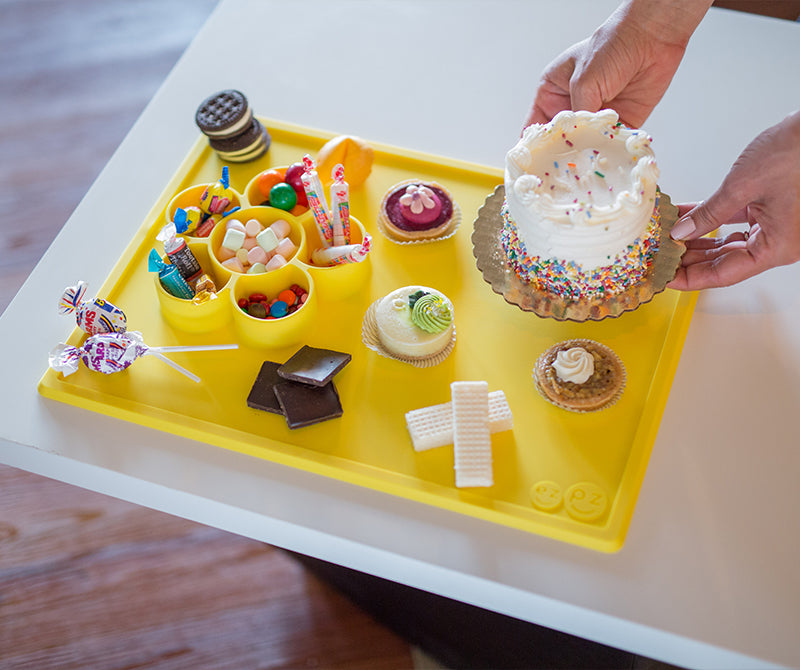Did the title of this blog surprise you? Is there really a child out there that refuses to eat dessert? Yes, there is! And being picky about candy can be just as devastating to the child + parent as picky eating with healthy foods. Learn why it’s important to help picky dessert eaters become more social!
Social Ramifications: As a feeding therapist, parents often confide in me about their fears regarding their child not eating. When kids refuse to eat desserts, parents are baffled and think they have the weirdest kid in the world. What child refuses cake? I recently had a conversation with a mom who said, “I used to be proud that my child refused to eat desserts, because it made me look like a good mom. But now my child is getting teased at birthday parties because of it. It’s so frustrating!”
The social ramifications of picky eating are complicated and stressful, regardless if your child is a picky protein eater or a picky dessert eater. Imagine how hard it is for these kiddos at classroom parties, Valentines Day, Halloween, Christmas, family gatherings, birthday parties, sporting events and team parties. The social implications are the same…isolation at mealtime.
Desserts: During the main meal it is socially acceptable for kids to get something different than everyone else. Dessert, however, has a HIGH social value, as it is a designated time for everyone to partake in the same food. At a birthday party, for example, when they serve cake and ice cream, it is assumed that all children will participate and enjoy this treat (unless they have food allergies). Picky dessert eaters not only decline dessert at a friend’s party, they will actually refuse to eat their own birthday cake! Mothers tell me tearful stories about their baby books that do not feature the traditional messy cake shot!
Candy & Sweets: The kids I work with that reject candy get frustrated, mostly because they feel like they are ‘supposed’ to like it. I had one child (the son of a professional baseball player) tell me, “Ms. Dawn…can you teach me how to like gum. All the other kids on my baseball team chew it and my dad says he wants me to be normal.” Ugh, poor buddy. Sports oftentimes have traditions that involve food, drinks, snacks or candy. By choosing to ignore these sacred moments, a child may isolate themselves from their social community.
Here are a few tips to help with your picky dessert eater:
Sprinkles: You want your child to enjoy chocolate? Try starting with a few chocolate sprinkles. You can find these in the baking section of the grocery store. They are usually used as a sprinkle for cupcakes and cakes, but they also are a great starting point for picky eaters. Put a few of these chocolate sprinkles on the Micro Mat so that it looks less overwhelming. Have them lick their finger and dab it into the sprinkles for a tiny taste.
Small Servings: If you want your child to have a few bites of cake on a special occasion, start by introducing cake pops. Again, it’s a small serving that is non-threatening when you are afraid to try something new. You can make your own cake pops, or easily find them at the grocery store or Starbucks. Explain to your child about each type of cake (vanilla, chocolate, etc.) and also explain the texture. A lot of my picky dessert eaters don’t like the dry taste of desserts, but find a gooey lava cake to be delicious!
Sugar: Some of my feeding clients don’t like the taste of sugar or artificial sweeteners in a rich, clumpy or solid form. For these kids, I start with a little spray of canned whipped cream. It’s a fun texture, especially for kids who require a lot of sensory stimulation. If my kiddo enjoys fruit, like sliced strawberries, peaches, raspberries or blackberries, than I squirt a little whipped cream on top. They usually want to squirt it themselves, which adds some fun to the experience! You can also try tossing a little bit of sugar (about a half teaspoon per serving) on their favorite fruit and let it chill for at least an hour, which makes great syrup. Remember, these are beginning steps to experience sugary tastes, which can lead to enjoying desserts!
Samples: Parents often say that they have tried everything when it comes to introducing desserts. But when I start listing them off, we usually find some new tasty treats to try! Here are a few examples: biscuits, cake, tarts, cookies, gelatin, ice cream, Jell-O, pastries, pies, pudding, custard, gingerbread, ice cream cake, brownies, cupcakes, muffins, cheesecake and popsicles. Some examples of candy and sweets are: lollipops, bubble gum, mints, chocolate, Halloween and Christmas candy, taffy, toffee, peanut brittle and frosting. Give a new dessert a try!
Social Language: Teach your child about some basic social language around desserts. It’s socially acceptable to ask for a ‘small serving’ or to ask someone to ‘share it’ with you. Empowering your child to learn social language can get them out of an uncomfortable eating situation and turn it into a fun time of sharing a bite or two with a friend!
Desserts are an important part of eating and socialization. How do you incorporate desserts into your child’s life? What candy or sweets do your children refuse? Let us know if your child is a picky dessert eater! #ezpzfun #dessert #pickyeater



